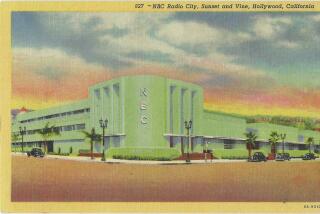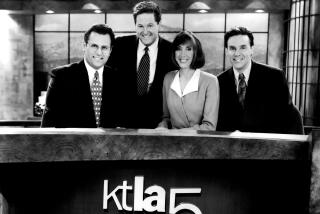KCRW manager plans to sign off
When Ruth Seymour arrived as a consultant for KCRW-FM (89.9) in September 1977, the station was operating out of a building at John Adams Middle School in Santa Monica and had the oldest transmitter west of the Mississippi.
“There was one typewriter, and it didn’t work. If you opened the door, you were on the playground of a junior high school,” Seymour said. “There was no place to go but up.”
Seymour helped transform KCRW from a small outlet with a weak Westside signal to the National Public Radio flagship in Southern California, broadcasting to Los Angeles, Palm Springs, and Orange and Ventura counties. On Wednesday, she announced that after 32 years, she would step down as general manager and retire at the end of February.
Seymour, 74, said that after three decades at any job, “you know you’re going to make that decision. It’s a question of when. For the last year I knew somehow, sometime, during the year I would leave.”
Her departure comes at a time when the station is seen to be in transition. Despite its reputation for superlative programming -- including its signature music and public affairs shows, such as “Morning Becomes Eclectic,” “Which Way, L.A.?” and “To the Point” -- KCRW lags behind other public radio stations in local-area ratings.
In October, the month in which the most recent ratings are available, KCRW placed 30th in the Los Angeles-Orange County market, with 1% of the total audience ages 6 and older. Classical station KUSC-FM (91.5) was 19th at 2.3%, while KPCC placed 24th at 1.8%.
But KCRW officials have challenged the ratings system, which they say undercounts the station’s true audience.
KCRW is looking to broaden its appeal nationally through digital initiatives such as streaming and podcasting. Seymour felt that having someone else in the general manager role might help the station more quickly realize that goal.
“It’s going to be a new era,” she said. “Time to begin without me.”
The personnel commission at Santa Monica College, which holds the station’s license, will review all applicants to replace Seymour and make a list of the top qualifiers; college President Chui L. Tsang ultimately will decide who will replace Seymour.
Seymour, most familiar to listeners for her distinctive role as a lead voice during pledge drives and as the sometime host of the program “The Politics of Culture,” demurred about whether she’d return to KCRW’s airwaves after February.
“I’m always available to them, but I cast a big shadow,” she said. “I don’t want to be a consultant and hang over somebody else. I think that would be inappropriate.”
In a farewell letter to station supporters, Seymour called KCRW “singular, idiosyncratic, daring, independent, smart and compelling.”
“That describes KCRW, but it also describes Ruth,” said Bill Davis, president of Southern California Public Radio, which operates KPCC-FM (89.3). “The current programming that KCRW has is indelibly stamped by Ruth.”
After growing up in South Bronx and attending City College of New York, Seymour moved to Los Angeles in 1961 and got a job as drama and literary critic at KPFK-FM (90.7), the listener-supported station owned by the left-leaning Pacifica Radio.
She became program director in 1971, and was there in 1974 when the FBI raided the station looking for tapes KPFK aired from the Symbionese Liberation Army, featuring kidnapped heiress Patty Hearst.
She left in 1976, and KCRW hired her the following year.
Warren Olney, host of “Which Way, L.A.?” and the nationally syndicated “To the Point,” insists that the audience for his public-affairs programs is much younger and broader than it would be without the complementary music shows on the station. He credits Seymour for developing KCRW’s eclecticism.
“I think she’s been able to create a balance,” he said. “People feel they can hear something on KCRW they can’t hear anywhere else. When you travel around the country and hear what other stations are broadcasting, and it all sounds the same, it is an achievement.”
In 1996, KCRW was the first station to carry “This American Life” outside of its home base, Chicago’s WBEZ. Host Ira Glass said of Seymour, who was an early supporter of his program, “I think she has a real instinctive gut confidence as a programmer that’s rare in public broadcasting. That’s why the station is so successful.”
She even had a hand in re-naming the show, originally called “Your Radio Playhouse.”
“She was very insistent that it was a terrible title,” Glass said. “If not for Ruth, we still might have the other title.”
In 1982, KCRW had less than 4,000 annual subscribers. That figure had grown to about 30,000 by 1990, and now stands at about 52,000. Seymour said that in 1978, after Proposition 13 cost the station a $100,000 stipend it had received from Santa Monica College, its first subscription drive netted $33,000.
KCRW first broke the $100,000 barrier in February 1984, raised just over $1 million in its winter 1998 drive, and now raises about $2 million in each of its semi-annual drives.
Apart from having more time to feed her passion for reading, Seymour said she has no specific plans for the future.
“At this moment, I’m not thinking about after,” she said. “You’re supposed to have plans -- it’s just not been my experience in life that’s the way I operate. I’m just trying to handle the present.”
She joked that if she had planned better, she would have made her announcement and then fled the country -- “get on a plane and go to Bhutan or someplace.”
“I’m not one who runs to the spotlight. I’m sure that would be disputed by people in the press,” she said, laughing.
--
More to Read
Sign up for Essential California
The most important California stories and recommendations in your inbox every morning.
You may occasionally receive promotional content from the Los Angeles Times.










